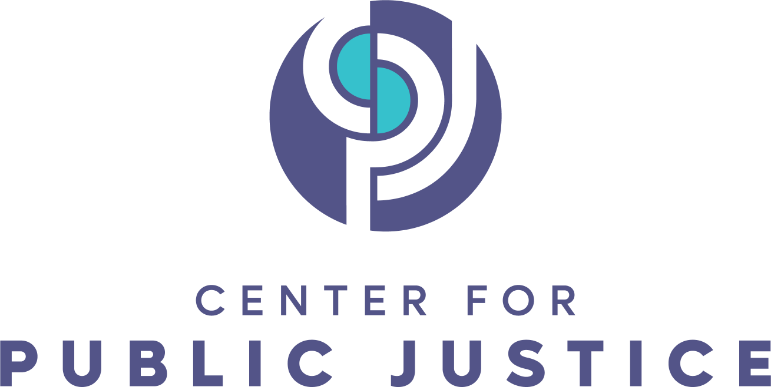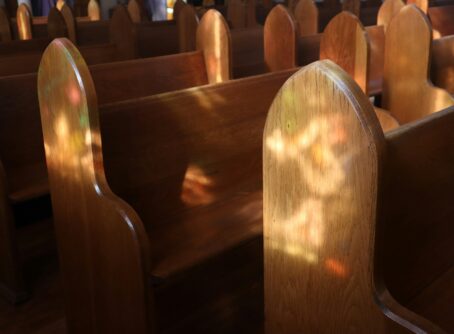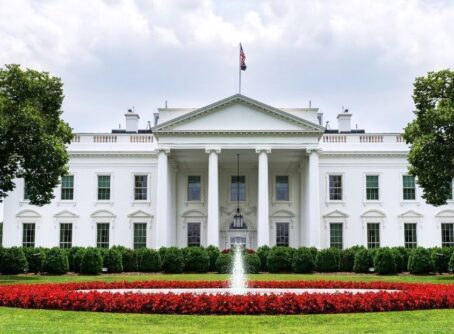
The rainbow is not a mere symbol—it is a sign, a covenant, a memory of mercy and a promise of justice. In the Christian tradition, the rainbow first appears after the great flood in Genesis, when God sets God’s bow in the clouds as a divine promise that God will never again destroy the earth by water. It is a symbol not of erasure or imposition, but of holy restraint and cosmic mercy.
“God is upholding His creation, keeping the rainbow in its place, showering us with grace for redeemed lives,” wrote James W. Skillen, founder of the Center for Public Justice, in 1988. Skillen described this “rainbow mercy and hope” as the foundation for a creation-renewal covenant with Noah, one extended through Abraham to all nations. This covenantal vision is not peripheral in Christianity—it is central to how the biblical narrative understands justice, continuity, and redemption.
But Christianity is not alone in assigning sacred meaning to the rainbow. In Lenape and other Algonquian-speaking Indigenous cultures, the legend of Rainbow Crow tells of a bird who brings fire to the freezing earth and is forever marked with iridescent, scorched feathers—a symbol of self-sacrificial love. In Theosophical and mystical Catholic traditions surrounding the Black Madonna, she is often depicted as encompassing all the colors of the rainbow, representing racial harmony, human dignity, and the fullness of creation.
Across spiritual traditions, the rainbow speaks of divine mercy, the costs of love, and a beauty born from suffering. This sacred symbolism for me also represents parents’ spiritual and ethical freedom to shape what their young children first hear and believe about life’s biggest covenantal questions: Is there a divine creative being? How ought we live together in relationships and communities that support flourishing? How do our family’s sacred animating beliefs call us to live in relation to God, ourselves, others and the natural world?
This sacred symbolism is precisely what is at stake in the ongoing legal battle in Montgomery County, Maryland—a conflict that reaches beyond the rainbow itself. It calls into question how public schools approach the formative education of young children, particularly around sensitive topics like identity, relationships, and belonging. It challenges whether schools can redefine foundational concepts without the meaningful participation of families for whom these themes carry deep spiritual, moral, and developmental significance.
The Legal Challenge in Montgomery County
At the heart of the case is a simple but profound question: do parents still have the right to be informed and to opt their children out of elementary school materials that present contested ideas about gender identity and sexuality? The Supreme Court recently heard oral arguments in Mahmoud v. Taylor, where families from Muslim, Jewish, and Christian backgrounds are challenging the Montgomery County Board of Education’s decision to eliminate parental notice and opt-outs for classroom storybooks that promote a particular vision of gender and sexuality.
These books are not limited to discussions of tolerance or respect. According to the petitioners and their legal counsel, the Becket Fund for Religious Liberty, the books include concepts such as gender self-identification, drag culture, and pride celebrations, aimed at children as young as three and four years old. One book includes vocabulary like “intersex flag” and “leather,” prompting children to match terms with images. Another implies that doctors merely “guess” a child’s sex at birth, presenting gender identity as wholly self-determined, without reference to biology or religious anthropology.
Previously, parents in Montgomery County had the right to be notified of such content and to decide whether their child would participate. This remains the case for older students during health class. But for pre-K through fifth-grade students, that right was quietly revoked in March 2023.
Arguments Before the Supreme Court
Mr. Eric Baxter, representing the parents before the U.S. Supreme Court, argued that schools nationwide have long managed broad opt-out policies without significant disruption. He warned that the Board’s new policy would permit schools to mandate any content—even potentially pornographic materials—without any parental recourse. “The First Amendment demands more,” he said. “Parents, not school boards, should have the final say on such religious matters.”
Justice Samuel Alito echoed these concerns. Referring to one storybook, he noted that while it presents same-sex marriage positively, it also portrays a child character, Chloe, who initially questions it—only to be corrected by her mother. Alito remarked, “It portrays this—everyone accepts this except for the little girl, Chloe… But her mother corrects her: “No, you shouldn’t have any reservations about this.”
Mr. Baxter pointed out that even Montgomery County principals had objected to the books’ age-appropriateness, describing them as dismissive of religion and shaming children who disagree. The school board itself withdrew two books from the curriculum, conceding that some concerns were valid. Yet it simultaneously maintained that no opt-outs would be allowed for the rest.
Justice Elena Kagan raised a key legal issue: how should courts draw lines in these disputes? Is the objection based on age, subject matter, or something else? Baxter responded that the books apply to children aged three to 11 and that objections tend to diminish as children grow older. He emphasized that parents are not seeking to purge materials, but to guide their children according to their faith during their most formative years.
Kagan pressed further, asking whether under Baxter’s argument, any subject that conflicts with a parent’s beliefs could be opted out of—even evolution in biology class. Baxter noted that Montgomery County’s own religious diversity guidelines once allowed for opt-outs in any case where a substantial burden was placed on a family’s religious beliefs. “Anything that violated a student’s—or imposed a substantial burden… on a student’s or parent’s religious beliefs, they had the right to opt out.”
This inconsistent application of rights lies at the center of the standing claim. Baxter highlighted that the Board allows opt-outs from choir or band if a student objects to religious songs, or even from holiday celebrations like Valentine’s Day. Yet, when Sherwood Elementary announced it would read one “inclusivity” book each day during Pride Month, no opt-out was permitted. “There’s this discrimination,” Baxter said, “where… some religious reasons get opted out, some don’t.”
The Broader Educational Landscape
Megan Stack, a New York Times opinion contributor who resides in Montgomery County, observed that opting out has long been a quiet but accepted part of American education. “Some parents who paid closer attention could and did opt out,” she noted, adding that this discretion didn’t attract much attention. Even in liberal districts like San Francisco, Portland, and Boston, Stack points out, parents can excuse their children from sex education. Some states—Utah, Nevada, North Carolina—go further by requiring parents to actively opt their children in.
What has historically made pluralism possible in public education is this quiet balance: a curriculum designed to foster respect and knowledge, alongside mechanisms that protect family conscience. Opt-outs have served not as an eraser of diverse ideas. Rather, opt-outs have allowed students whose families adhere to counter-cultural spiritual and/or moral beliefs to be able to thrive without being crushed with conformity or worse, cancel culture.
Public Justice and Structural Pluralism
What’s at stake here is not just about parental control. It is about structural pluralism and public justice. The public school system is a civic good—a place where children from diverse backgrounds gather for shared learning. But civic goods cannot remain healthy if they marginalize entire communities or present one set of beliefs as uniform and monolithic. When the sacred meanings behind deeply held symbols—like the rainbow—are flattened into one political or ideological expression, we lose not only the richness of that symbol but also the shared space of democratic education.
Pluralism is not permissiveness. It is a civic practice of accommodation rooted in respect. When school districts dismiss or override deeply held religious objections without due process, they tilt the balance away from civic hospitality and toward bureaucratic imposition.
When I moved to Montgomery County in 2012, I was newly out of law school, single, and serving in a local church. Over the years, I listened as parents wrestled with whether their values still had a place in the public school system. Now as a mother, I confront those same questions.
We want our children to live in communities of empathy, honesty, and care. But we also want them to inherit the sacred stories that form our conscience. The rainbow—in Scripture, in legend, in mystical theology—is a sign not of conquest, but of coexistence. It calls us to remember mercy, to practice restraint, and to keep covenant with one another across deep differences.
To restore the rainbow to its full meaning is not to erase anyone. It is to recognize that public life flourishes when pluralism is real. When parents are trusted. When the sacred is not reduced to a slogan. And when justice, like the rainbow, is allowed to stretch across the sky—wide enough to shelter us all.
A Covenant for Our Time
The Supreme Court’s decision in Mahmoud v. Taylor, expected by the end of June, may mark a turning point. But regardless of how the Court rules, this case raises questions that will continue to shape the American educational landscape. Can public institutions still honor the sacred commitments that families carry into shared spaces? Can pluralism survive when disagreement is treated as defiance?
The rainbow is not the property of any one group. It is a sign entrusted to us all. As we wrestle with how to teach our children about identity, freedom, and belonging, we would do well to return to the rainbow’s original promise: not to dominate, but to offer mercy and hope. To promote and redeem life for all God’s creation, including those who hold very different views than our own.
At its core, this case is also about institutional religious freedom—the freedom of families, faith communities, and sacredly rooted institutions to form the moral and spiritual conscience of the next generation without interference or dilution by the state. It’s not just about individual parental rights. It’s about whether the communities that carry the sacred—churches, synagogues, mosques,temples, religious schools, spiritual and faith-based nonprofits serving all walks of life —and the families shaped by them—can still inhabit public life without being forced to bracket their deepest convictions. When the state flattens the sacred into a single ideological story, it violates more than just privacy or preference—it threatens the ecosystems of meaning that sustain pluralism. Institutional religious freedom protects not just the right to believe, but the right to form, to teach, and to shape sacred meanings deep into the hearts of individuals, families and communities. The rainbow, in all its sacred significance, is a sign of this covenantal space—a promise that public life can still make room for difference, reverence, and the freedom to be formed by something higher than the state. That is the real work of education in a democracy. And it is the real test of whether our public square can hold space for the sacred in every color and shade.
Chelsea Langston Bombino is a believer in sacred communities, a wife, and a mother. She serves as a program officer with the Fetzer Institute and a fellow with the Center for Public Justice.




